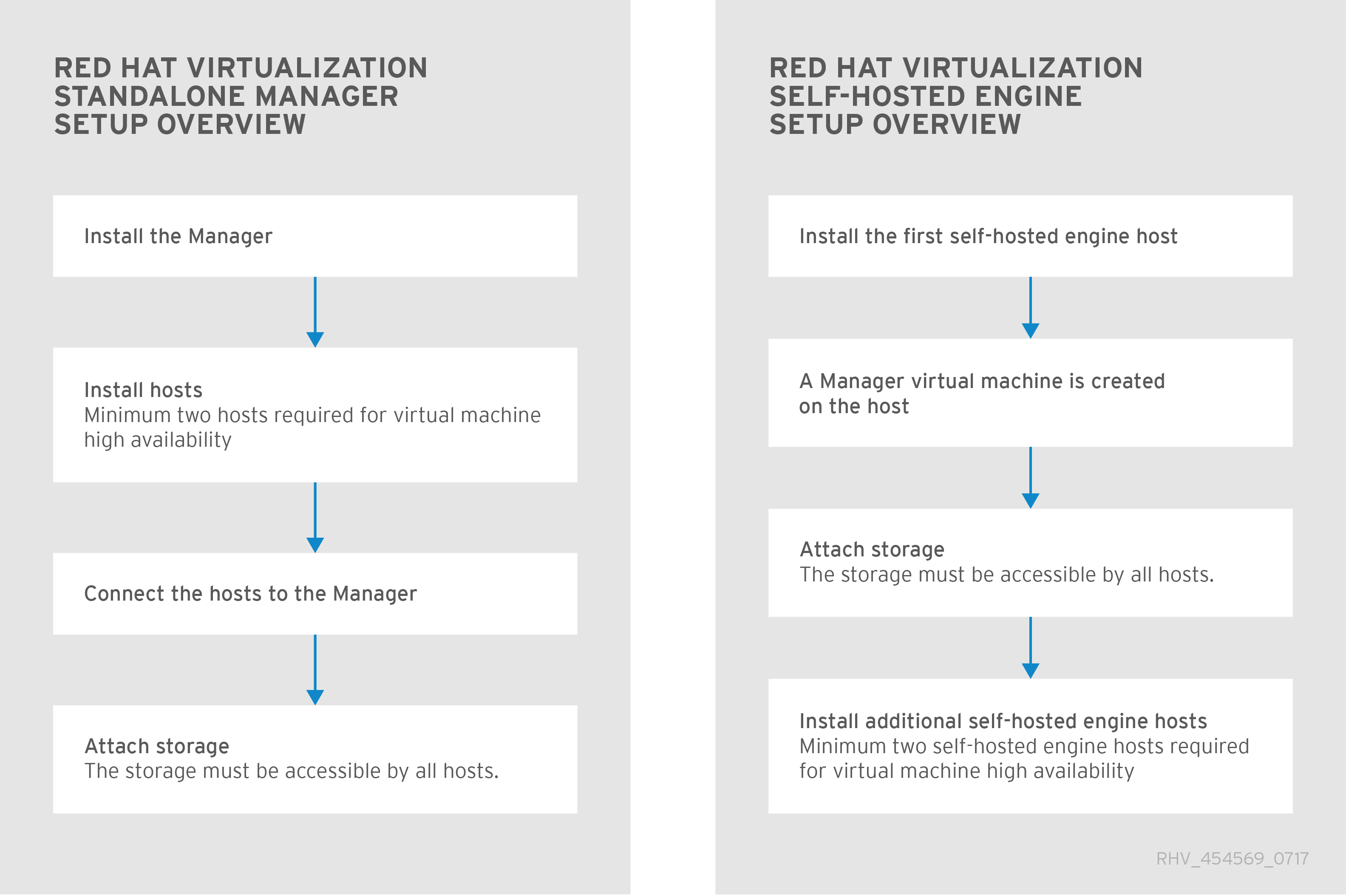Ce contenu n'est pas disponible dans la langue sélectionnée.
Chapter 3. Installing Red Hat Virtualization
3.1. Red Hat Virtualization Installation Overview
The following diagram outlines the setup procedure for a standalone Manager deployment and a self-hosted engine deployment.
Figure 3.1. Setup Overview of Red Hat Virtualization
3.2. Red Hat Virtualization Installation Options
3.2.1. Self-hosted engine (recommended)
You can install Red Hat Virtualization as a self-hosted engine using the command line.
Because the Manager installation is automated, the Manager database (engine) and Data Warehouse service and database (ovirt-engine-history) can only be installed locally. If you want to host any databases or services on remote machines, you must migrate them after the installation is complete. Instructions for this are included in both of the following guides.
To install a self-hosted engine using the command line, see Installing Red Hat Virtualization as a self-hosted engine using the command line.
3.2.2. Standalone Manager (manual)
You can only install a standalone Manager using the command line.
During installation, you can specify whether to install the Manager database (engine) and Data Warehouse service and database (ovirt-engine-history) locally or remotely. You do not have to choose the same option for both; one database can be hosted on a remote machine, while the other is hosted on the Manager machine.
Local databases can be manually configured, or automatically configured by the installation script. A remote Manager database must be manually configured. A remote Data Warehouse database can be configured automatically only if the Data Warehouse service is installed on the same machine (if not, the database must be configured manually).
- To install a standalone Manager with local databases, see Installing Red Hat Virtualization as a standalone Manager with local databases. This guide assumes that all databases and services will be installed on the same machine as the Manager.
- To install a standalone Manager with remote databases, see Installing Red Hat Virtualization as a standalone Manager with remote databases. This guide assumes that all databases and services will be installed on one additional machine separate from the Manager.
Mixing local and remote databases
Installing one database on the Manager machine and the other database remotely, and the various combinations thereof, is not specifically documented. For example:
- The Manager and Manager database are installed on the Manager machine, and the Data Warehouse service and database are installed on Server 1. In this case, you must configure the Manager locally, then install Data Warehouse separately.
- The Manager and the Data Warehouse service are installed on the Manager machine, and the Manager database and Data Warehouse database are installed on Server 1. In this case, you must manually configure the Manager and Data Warehouse databases, then configure the Manager and the Data Warehouse service.
- The Manager, Manager database, and Data Warehouse database are installed on the Manager machine, and the Data Warehouse service is installed on Server 1. In this case, you must manually configure the Data Warehouse database, then configure the Manager, then install the Data Warehouse service.
- The Manager and the Data Warehouse service are installed on the Manager machine, the Manager database is installed on Server 1, and the Data Warehouse database is installed on Server 2. In this case, you must manually configure the Manager and Data Warehouse databases, then configure the Manager and the Data Warehouse service.
- The Manager is installed on the Manager machine, the Manager database is installed on Server 1, and the Data Warehouse service and database are installed on Server 2. In this case, you must manually configure the Manager database, then configure the Manager, then install Data Warehouse.
